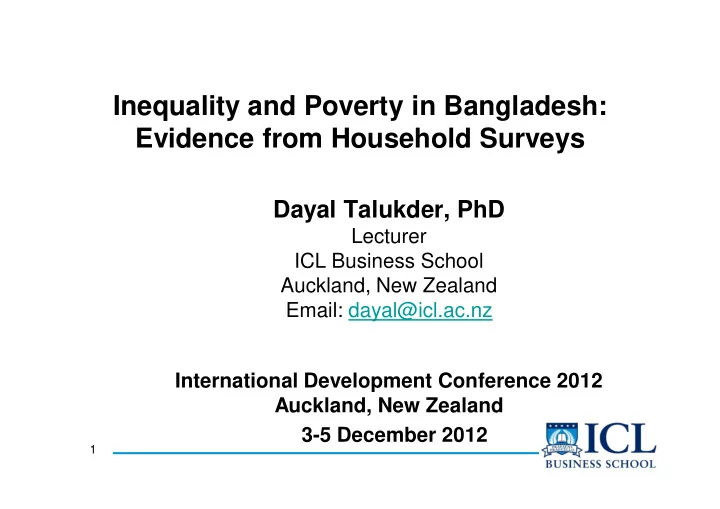

Inequality and Poverty in Bangladesh: Evidence from Household Surveys Dayal Talukder, PhD Lecturer ICL Business School Auckland, New Zealand Email: dayal@icl.ac.nz International Development Conference 2012 Auckland, New Zealand 3-5 December 2012 1
Basic development indicators of Bangladesh economy Indicators 2010 Land area (sq km) 147570 Population (million) 162 Population density (per sq km) 1229 GDP (billion US dollars) 89.38 GNI per capita (US dollars) 590 Real GDP per capita growth (percent) 4.3 Life expectancy at birth (year) 66 Infant mortality (per 1000 live births) 52 Adult literacy (% of 15+ population) 55 Population below national poverty line (latest survey year 2005) 40 Child malnutrition (% of children under 5 years) 42 2
Percentage share of rural and urban households 100 83.63 80 73.17 Percent 60 40 26.83 16.37 20 0 1995-96 2010 Rural Urban 3
Percentage share of income of household by main income sources: 2010 3.93 20.44 13.62 4.27 19.00 35.55 Agriculture Business & commenrce Wages and salary Rent Remittance and gift Other sources 4
Economic performance and poverty reduction Average growth in GDP (1995-96 to 2010): 5.8% Average poverty reduction over this period: 1.2% Poverty reduction: insignificant 5
Research objective, Scope and limitation Objectives: To investigate a link between economic growth, inequality and poverty To decompose inequality and poverty by rural and urban households Scope Period: 1995-96 to 2010 Rationale of period selection: Post-liberalisation Limitations: Secondary data: HIES 1995-96 and HIES 2010 from Bangladesh Bureau of Statistics (BBS) 6
Theoretical and empirical aspects • Economic growth contribute to poverty reduction subject to – Initial level of inequality: low – Changes in inequality over time: decrease Methodology • Poverty and inequality measures: • Haughton and Khandker (2009) • Sectoral decomposition of changes in poverty and growth-inequality decomposition • Datt and Ravallion (1992) • Ravallion and Datt (2002) • Ravallion and Chen (2003) • Ravallion (2004) 7
Inequality in Bangladesh: an overview Percentage share of household income by decile 40 35.85 35 1995-96 2010 30 25 Percent 20 15.94 15 11.56 9.06 10 7.32 6.01 5.1 4.1 5 3.22 2 0 8
Inequality: Gini coefficient for household income distribution 1995-96 2000 2005 2010 Average change (%) Gini 0.38 0.39 0.42 0.46 1.40 Note: Change shown between years 1995-96 and 2010 9
Decomposition of inequality by urban and rural areas 1995-96 2010 GE(0) GE(1) GE(2) GE(0) GE(1) GE(2) National 21.3 27.9 47.5 26.5 29.3 41.3 Urban 25.6 29.2 41.6 22.0 23.1 29.4 Rural 13.5 14.0 45.1 17.9 22.7 38.9 Within-group inequality 13.2 20.1 39.6 19.9 23.0 35.1 Between-group inequality 8.0 7.9 7.9 6.6 6.3 6.2 Between as a share of total 37.8 28.1 16.6 24.8 21.5 15.0 10
Overall Poverty: Poverty Headcount Rate 1995-96 2010 Change Upper poverty line 35.3 20.8 -14.5 Urban 55.5 36.0 -19.5 Rural 46.6 28.6 -18.0 National Lower poverty line 13.5 8.0 -5.5 Urban 39.5 21.3 -18.2 Rural 28.0 14.8 -13.2 National Note: Changes shown between years 1995-96 and 2010 11
Overall Poverty: Poverty Gap and Squared Poverty Gap Poverty Gap Squared Poverty Gap 1995-96 2010 Change 1995-96 2010 Change Upper poverty line Urban 7.7 5.4 -2.3 2.7 2.0 -0.7 Rural 9.2 8.4 -0.9 2.2 2.8 0.6 National 8.6 6.9 -1.6 2.4 2.4 0.0 Lower poverty line Urban 3.7 2.0 -1.7 1.3 0.6 -0.6 Rural 5.4 4.4 -1.0 1.2 1.3 0.1 National 4.7 3.3 -1.4 1.2 1.0 -0.2 Note: Changes shown between years 1995-96 and 2010 12
Urban-rural Poverty Decomposition Upper Poverty Line Lower poverty Line Absolute Percentage Absolute Percentage change change change change Change in poverty -17.99 100.00 -13.25 100.00 Total Intra-sectoral effect -17.26 95.98 -12.62 95.24 Population-shift (inter- -0.96 5.34 -1.24 9.33 sector) effect Interaction effect 0.24 -1.32 0.60 -4.56 Intra-sectoral effects: Urban -6.38 35.49 -2.42 18.30 Rural -10.88 60.49 -10.19 76.94 Note: Changes shown between years 1995-96 and 2010 13
Growth and redistribution decomposition of poverty changes Change in incidence of poverty Actual 1995-96 2010 change Growth Redistribution Interaction Upper poverty line National 46.57 28.59 -17.99 -46.52 43.05 -14.51 Urban 35.26 20.79 -14.47 -35.26 46.94 -26.15 Rural 55.50 36.03 -19.46 -55.40 39.48 -3.54 Lower poverty line National 28.02 14.77 -13.25 -27.97 55.52 -40.80 Urban 13.47 7.97 -5.50 -13.47 58.43 -50.46 Rural 39.51 21.27 -18.24 -39.41 52.58 -31.40 Note: Changes shown between years 1995-96 and 2010 14
Elasticity of Poverty with Respect to the Inequality Poverty Headcount Rate Poverty Gap Squared Poverty Gap 95-96 2010 Change 95-96 2010 Change 95-96 2010 Change Upper poverty line Urban 2.34 2.40 0.14 4.55 4.76 0.21 5.42 6.15 0.73 Rural 1.06 1.23 0.17 1.06 2.78 1.73 1.97 4.07 2.10 National 1.62 2.43 0.80 3.32 4.40 1.08 4.32 5.75 1.43 Lower poverty line Urban 2.51 3.93 1.41 5.32 7.25 1.93 7.03 8.36 1.33 Rural 1.07 1.98 0.91 1.78 4.28 2.50 2.77 5.61 2.84 National 2.28 3.67 1.39 4.41 6.55 2.14 5.58 7.68 2.10 Note: Changes shown between years 1995-96 and 2010 15
Conclusions Bangladesh experienced high economic growth during 1995-96 to 2010 Inequality also increased over this period So poverty reduction was insignificant If inequality were held constant at the 1995-96 level, Bangladesh could reduce poverty to zero in 2010 Rural households experienced a larger reduction in poverty than unban households income sources of urban households: more diverse causing higher inequality Policy recommendation: government should formulate policy to reduce inequality for significant poverty reduction policies include: income transfer to poor, progressive income tax 16
THANK YOU Questions? Comments Dayal Talukder Email: dayal@icl.ac.nz 17
Recommend
More recommend